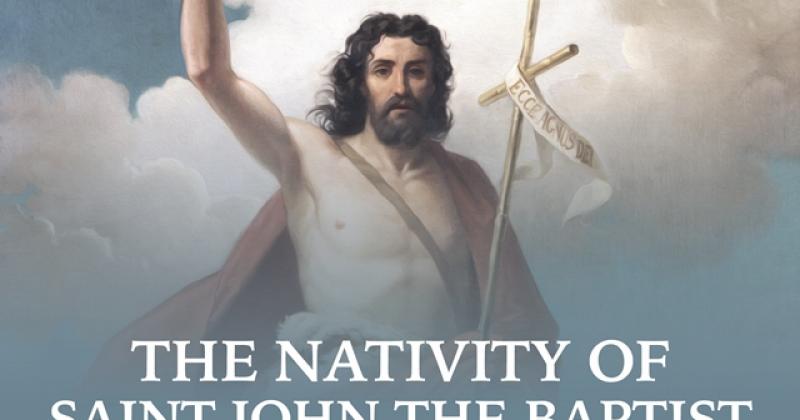“A voice of one crying in the wilderness, prepare the way for the Lord.” Isaiah 40:3
When Mary visited and greeted Elizabeth the mother of St. John the Baptist, Elizabeth was filled with the Holy Spirit (cf. Luke 1: 39-41). This passage from St. Luke forms a theological basis that John the Baptist, while not conceived without original sin, was born without it.
Characteristics of St. John
While John was in prison, Jesus considered him to be more than a prophet (Matthew 11: 7-9). According to Church Fathers John Chrysostom and Ambrose of Milan, John the Baptist was more than a prophet because:
1- A prophet receives gifts of God, but John was able to give the gift of baptism to God. By doing so, John became enlightened that he recognized the true Messiah in Jesus, calling him from the moment he saw him “the Son of God” and “the Lamb of God” and the immortal.
2- A prophet predicts what God will achieve and all prophets have made predictions about Christ, but no one has predicted anything about them. St. John made predictions about Christ, but of him other prophets prophesied.
3- These prophets were all carriers of the Word but he was the voice; and as the voice is closest to the Word, so St. John the Baptist was closest to Christ; and yet he was not Christ.
St. John the Baptist was effective in the proclamation of baptism as people went into the desert and were baptized by him in the Jordan River. He baptized Jesus who he referred to as the Son of God. He used Baptism as a means for salvation and the forgiveness of sins.
Being a great orator, he spoke to the multitude regardless of their social class and was referred to as “the voice of one crying in the wilderness”. He defied political power resulting in his imprisonment in Machaerus where he was beheaded at the request of Herodias, the adulterous wife of Philippus, Herod’s brother.
Furthermore, one cannot overlook the similarities between St. John the Baptist and Jesus Christ. Their parents were promised a child by God. The name of the child was also given by Archangel Gabriel, the same angel sent in both circumstances.
The tomb of St. John
The tomb of St. John is unknown. The crusaders built a basilica for his honor in Nablus. According to St. Jerome, his tomb lies in Sebaste (old Samaria).
Holidays of St. John the Baptist
From the earliest Christian times, the faithful started celebrating different holidays and festivals in honor of St. John the Baptist. The holiday of “Birth of St. John” had its origin in the fifth century where it was celebrated in the East and the West six weeks prior to the birth of Jesus on June 24. Among the many customs that are connected to this day is the “St. John’s fire”, a celebration given significance by the renowned canonist and medieval liturgist William Durandus, who saw in the fire a reference to the “precursor of the Lord who was a burning light”, and a sign of that joy and cheer the Archangel Gabriel said St. John would bring to the world. “The Annunciation of the Conception of John” was also an early holiday that dates back to the fourth century. In the fifth century the “Beheading of the John the Baptist” was celebrated on August 29 in the Orient.
St. John the Baptist in the art
Baptismal Churches were also distinct monuments built in honor of St. John the Baptist. The Baptistery of Florence is one of them. The building goes back to the fifth century and restored in the eleventh century. Its eight-part cupola is replete with mosaics depicting scenes from the Bible. One of these scenes includes the representation of the condemnation of the Baptist. In the picture Herod and Herodias, on the right side, represent tyranny, corruption of power and false judgement. Such depictions had a political significance that can be compared to “mirror for princes”* of the Middle Ages. The purpose of these scenes was to remind people in authority that power should be exercised with justice and in compliance with the law.
Moreover, the Basilica of the Lateran, which is one of the four major papal basilicas of Rome and its baptismal temple San Giovanni, assumed the name of St. John (Lateran Basilica was co-dedicated in honor of St. John the Baptist and St. John the Evangelist centuries later, after the Basilica was originally dedicated to Christ the Savior.) In the Polish city of Wrocław, where John the Baptist was made its patron saint, his head was incorporated in the city’s coat of arms.
The Deësis in the Hagia Sophia
The mosaic of the Deësis represents the mediatorship of St. John the Baptist on the left side of Christ the Pantocrator and the Mother of God on his right. Both are imploring Jesus for the forgiveness of sins. St. John the Baptist is characterized by the inscription as “Prodromos” which means the precursor. Thomas Whittemore, the archaeologist who discovered the mosaic, believed that the Deësis might go back to the early twelfth century for two reasons: the form of the letters of the inscription and the similarity of the Mother of God with the Mother of God of the Vladimir icon.
When viewers stand in front of this work of art, they can see the humility that St. John the Baptist reflects through his facial expressions; the humility of a mediator who knows sorrow in the world and the sinfulness of man.
